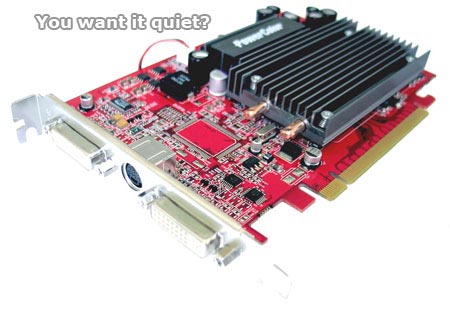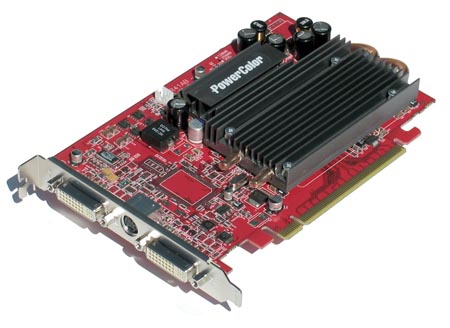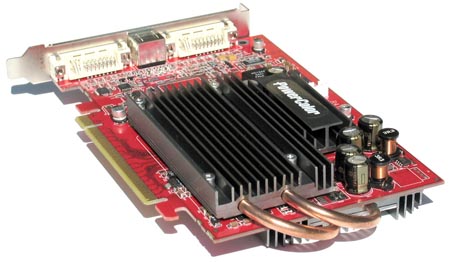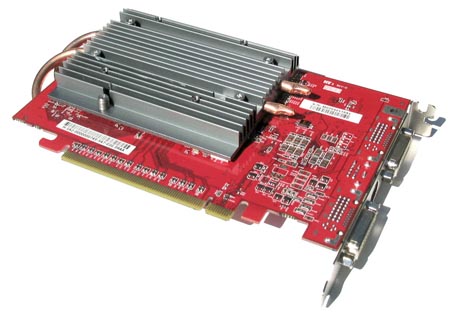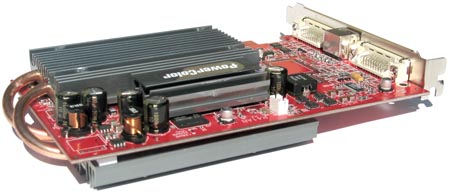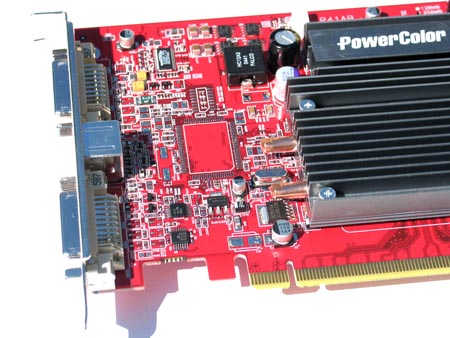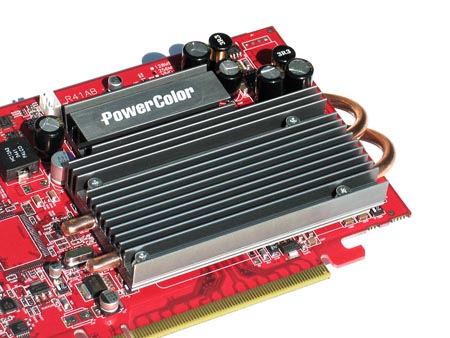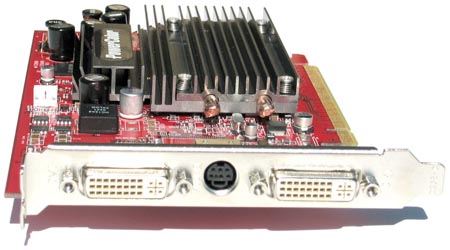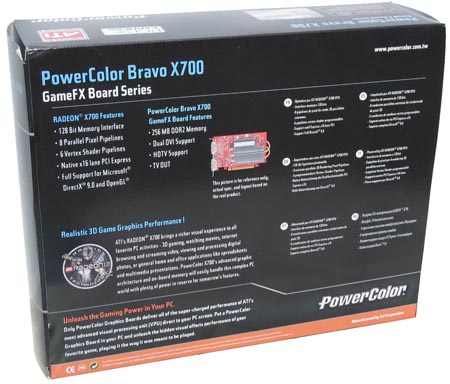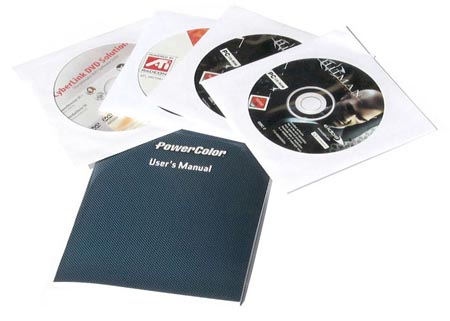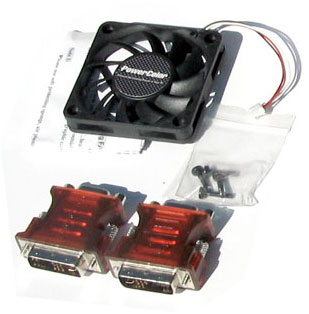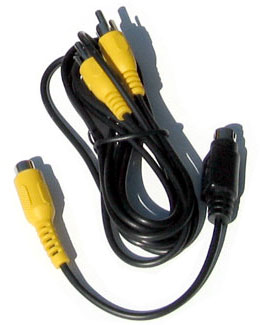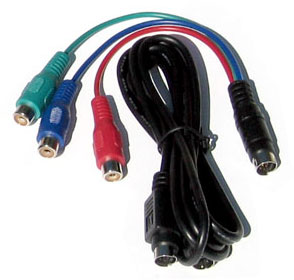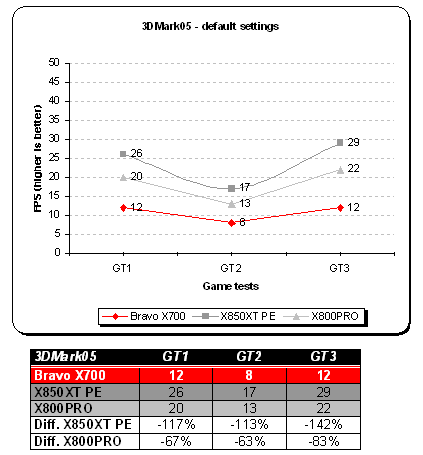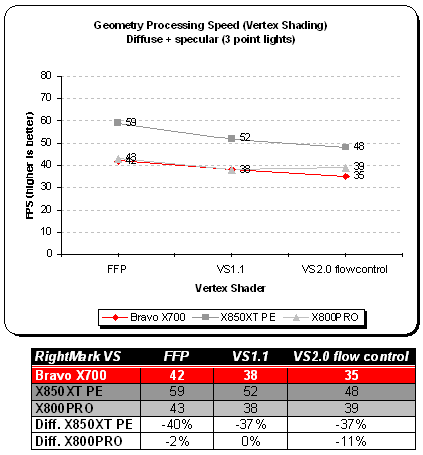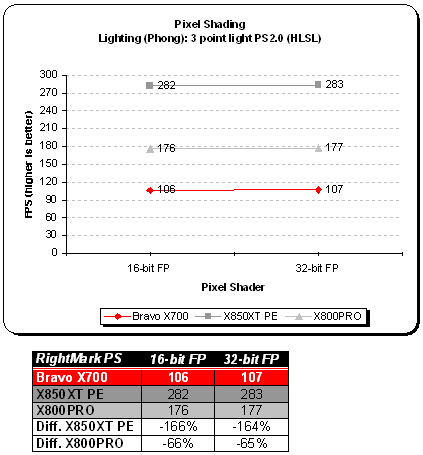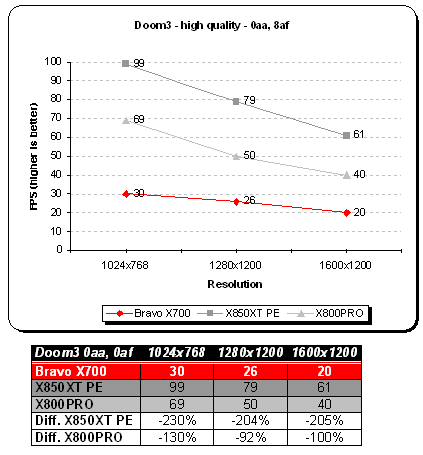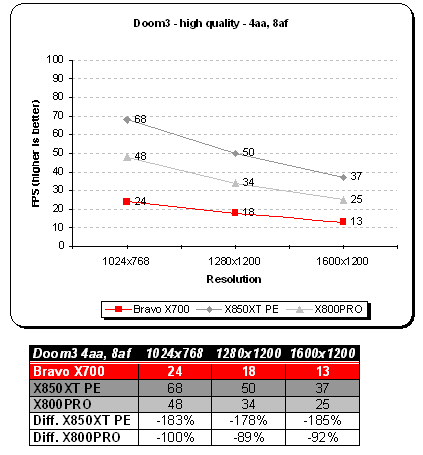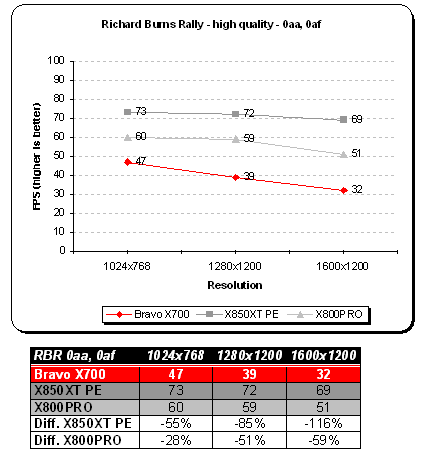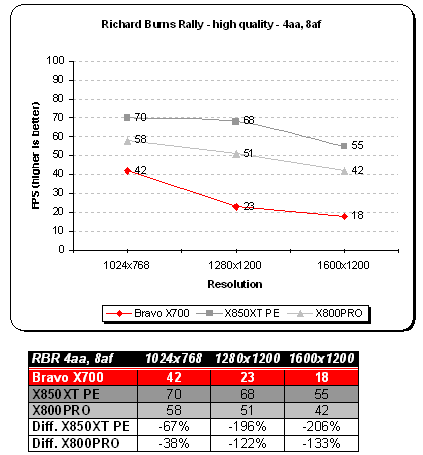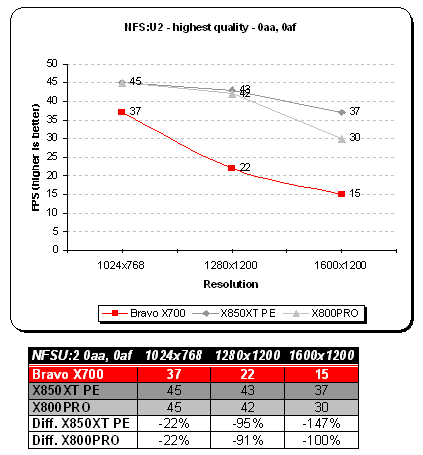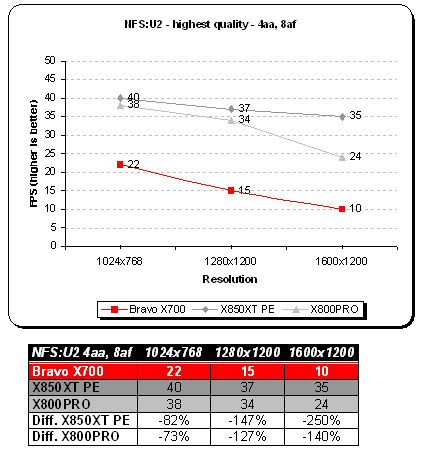If you are looking for a mid-range card with passive cooling system, Tul is one of the companies that offer such solution on X700 based cards. With good performance in its class and okay bundle, PowerColor Bravo X700 is an interesting product to consider. The Silent Cooling System has proven to be a worthy addition, the passive solution performed marvelously and ran very cool.
Introduction
Today we have another PowerColor offering for you to look at. This time around we will be stressing a PowerColor Bravo X700 — a fancy name if you ask, but holds some truth nevertheless. A few weeks ago we gave you our thoughts on PowerColor X850XT PE VIVO AGP edition, a flagship card based on ATI’s R481 VPU. Moving away from enthusiast market, I will focus on the mid-range sector today instead. Let me point out that PowerColor (Tul Corp’s brand) was one of the first to position ATI’s X700 on the market. The card we have in our lab today is SFF (Small Form Factor) friendly, and I can assure you, most builders will drool over it. Okay so I spoiled the fun with the picture below? Maybe, but definitely not everything.
If you remember back in November of 2004, Tul announced a PowerColor X700 XT. The card was equipped with SCS (Silent Cooling System) mechanism instead of regular fan. In December, Tul decided to release X700 PRO based card which also sported SCS. April of 2005 brings us PowerColor Bravo X700. Suggested retail price is pretty competitive and weighs just about $160 with tax. ATI based RV410 cards can be found in quite a few flavors, i.e. different VPU clocks and / or memory type — it all depends on the Add-In-Board manufacturer and most importantly customer needs. More on that can be found over at Beyond3D.
For those not in the know, Tul Corporation is a Tier-1 provider of ATI-based graphic cards. The company is also a leader in providing motherboards and barebone systems. So, what about PowerColor?
PowerColor is a consumer brand focused on providing cutting-edge graphics card products to retail customers. Our goal for the Tul brand is to be the industry’s number one provider of technology product solutions. Our goal for the PowerColor brand is to be the world’s number one brand of graphics cards. PowerColor is in effect owned by Tul Corporation, however the brands are operated independently of each other.
VPU Specifications
| PowerColor |
Bravo X700
|
X850 XT PE
|
X800 PRO LAE
|
RADEON 9800 PE
|
| VPU (256-bit) |
RV410
|
R481
|
R420
|
R360
|
| Chip Architecture |
.11µ (TSMC fab)
|
.13µ low-k (TSMC fab)
|
.13µ low-k (TSMC fab)
|
.11µ (TSMC fab)
|
| Transistors |
~120 Million
|
~160 Million
|
~160 Million
|
~110 Million
|
| Memory Architecture |
128-bit
|
256-bit
|
256-bit
|
128-bit
|
| Frame Buffer Size |
256 MB GDDR-2
|
256 MB GDDR-3
|
256 MB GDDR-3
|
128 MB DDR I BGA
|
| Pixel Pipelines |
8
|
16
|
12
|
8
|
| Vertex Pipelines |
6
|
6
|
6
|
4
|
| TMU(s) per Pipeline |
1
|
1
|
1
|
1
|
| Engine |
SMARTSHADER HD
|
SMARTSHADER HD
|
SMARTSHADER HD
|
SMARTSHADER HD
|
| Bus Type |
PCI-e 16x
|
AGP 8x, 4x
|
AGP 8x, 4x
|
AGP 8x, 4x
|
| Core Clock |
400 MHz
|
540 MHz
|
475 MHz
|
380 MHz
|
| Memory Clock |
532 MHz DDR
|
1180 MHz DDR
|
900 MHz DDR
|
600 MHz DDR
|
| RAMDACs |
2x 400 MHz DACs
|
2x 400 MHz DACs
|
2x 400 MHz DACs
|
2x 400 MHz DACs
|
| Memory Bandwidth |
8.5 GB / sec
|
37.6 GB / sec
|
28.8 GB / sec
|
9.6 GB / sec
|
| Pixel Fillrate |
3.2 GPixels / sec
|
8.6 GPixels / sec
|
5.7 GPixels / sec
|
3.0 GPixels / sec
|
| Texel Fillrate |
3.2 GPixels / sec
|
8.6 GTexels / sec
|
5,7 GTexels / sec
|
3.0 GTexels / sec
|
| DirectX Version |
9.0c
|
9.0c
|
9.0c
|
9.0
|
| Pixel Shader |
2.0b
|
2.0b
|
2.0b
|
2.0
|
| Vertex Shader |
2.0
|
2.0
|
2.0
|
2.0
|
As you can see, there are some differences between these chips. Obviously the X700 is based on 128-bit memory architecture, but unlike the RADEON 9800 PE, the Bravo X700 features 256 MBs of GDDR-2. The RV410 also sports PCI-e bus whereas the other VPU’s are built on ATI’s native AGP architecture. The weakest part (from the specifications perspective) of the Bravo X700 are its memory modules: GC37 chips are the slowest of all K4N56163QF’s. They are rated at a miserable 266 MHz (532 MHz DDR), which accounts for lower memory bandwidth when compared with PowerColor RADEON 9800 PE. This is the slowest X700 currently available on the market. Later on, I will show you our overclock results so you can see how far the memory can be pushed.
SMARTSHADER™ HD
- Support for Microsoft® DirectX® 9.0 programmable vertex and pixel shaders in hardware
- DirectX® 9.0 Vertex Shaders
- Vertex programs up to 65,280 instructions with flow control
- Single cycle trigonometric operations (SIN & COS)
- DirectX® 9.0 Extended Pixel Shaders
- Up to 1,536 instructions and 16textures per rendering pass
- 2nd generation F-buffer technology accelerates multi-pass pixel shader programs with unlimited instructions
- 32 temporary and constant registers
- Facing register for two-sided lighting
- 128-bit, 64-bit & 32-bit per pixel floating point color formats
- Multiple Render Target (MRT) support
- Complete feature set also supported in OpenGL® via extensions
SMOOTHVISION™ HD
- 2x/4x/6x Anti-Aliasing modes
- Sparse multi-sample algorithm with gamma correction, programmable sample patterns, and centroid sampling
- Lossless Color Compression (up to6:1)at all resolutions, including widescreen HDTV resolutions
- Temporal Anti-Aliasing
- 2x/4x/8x/16x Anisotropic Filtering modes
- Up to 128-tap texture filtering
- Adaptive algorithm with bilinear (performance) and trilinear (quality) options
3Dc™
- High quality 4:1 Normal Map Compression
- Works with any two-channel data format
HYPER Z™ HD
- 3-level Hierarchical Z-Buffer with Early Z Test
- Lossless Z-Buffer Compression (up to 48:1)
- Fast Z-Buffer Clear
- Z Cache optimized for real-time shadow rendering
- Optimized for performance at high display resolutions, including widescreen HDTV resolutions
VIDEOSHADER™ HD
- Seamless integration of pixel shaders with video in real time
- FULLSTREAM™ video de-blocking technology for Real, DivX, and WMV9 formats
- VIDEOSOAP™ noise removal filtering for captured video
- All-format DTV/HDTV decoding
- Adaptive Per-Pixel De-Interlacing and Frame Rate Conversion (temporal filtering)
DISPLAY FEATURES
- Dual integrated display controllers
- Dual integrated 10 bit per channel 400 MHz DACs
- Integrated 165 MHz TMDS transmitter (DVI 1.0 / HDMI compliant and HDCP ready)
- Integrated TV Output support up to 1024×768 resolution
- YPrPb component output for direct drive of HDTV displays†
- Single and dual link external TMDS transmitter support for high resolution and/or multi-monitor DVI configurations
- Compatible with ATI’s THEATER™ video decode and capture devices for VIVO (Video Input / Video Output) configurations on certain X800 graphic cards
ADDITIONAL FEATURES
- Windows® Logo Program compliant
- CATALYST™ Software Suite
In terms of feature set, there are no major differences from R300 / R350 VPUs, except for improved pixel / vertex shader instructions and additional map compression.
The Card
The mid-rage sector is where most competition comes from. With a variety of VPU configurations and specifications, there is a vast amount of cards to choose from. Vendors will try to broaden their offering with fancy coolers / heatsinks, better bundles or lower price tags just to get to the customer. In our case, PowerColor Bravo X700 is one of those cards. Due to slower memory clocks, this is not your standard X700 card. Let’s take a look at the board itself.
The obvious difference with this card is its cooling system. PowerColor advertises it as SCS – Silent Cooling System which is also slapped on PowerColor SCS X700 PRO. This version of the SCS however, is greatly improved and covers the RAM modules on both sides.
The card itself is pretty heavy due to aluminum heatsinks covering both the VPU and RAM. For better heat circulation and dissipation, both blocks are connected with copper heatpipes. On the back of the card, PowerColor decided to drill holes for 60 mm fan. The included fan isn’t anything special, but if you want to overclock it, it will definitely help. The good thing is that you don’t have to use their fan. If you have enough room above your card, you can slap on a custom ~50 CFM fan, and it should perform much better than the one from PowerColor.
Again, PowerColor’s passive cooling system from a closeup.
The card features dual DVI ports so if you’ve got two LCD displays, you will be very pleased to use it. Additionaly, there is HDTV support for those that want to unleash the power of High Definition output.
Bundle
As with the PowerColor X850 XT PE VIVO AGP we reviewed a few weeks ago, the card comes in a standard cardboard box.
The front and back of the box highlights cards specifications and included bundle. In the middle of the box, you are presented with the Silent Cooling System that’s used on the video card. The back of the box sports specs and some marketing catch phrases. Overall I was very pleased with the design of the box, nothing fancy or over colored yet stylish and useful.
Above you can see the included manual, three CDs and a DVD. PowerColor includes two DVI-to-VGA adaptors, a 60 mm fan + screws and instructions on how to mount it on the passive cooling system.
Included in the bundle we have
- Accessories HDTV Cable
- Video in/out Cable
- S-Video Cable
- Composite Cable
- 2 DVI-I Connectors
- User’s Manual
- Software bundle
- Driver CD
- CyberLink DVD Solutions PowerDVD 5
- PowerProducer 2 Gold DVD
- PowerDirector 3
- Power2Go 3
- Medi@show 2
- Hitman 2 full game
Setup and Installation
Below you will find the complete system configuration as well as benchmarks used in this review.
|
Test system specifications
|
|
|
PowerColor Bravo X700 PCI-e (system #1) |
|
Benchmarks
|
|
Synthetic benchamrks: 3DMark 2005 (build 1.2.0) — default settings |
|
Game benchmarks: Doom 3 (default demo + Fraps) |
Putting the card in did not require taking out other components. Upon bootup, I realized the SCS is silent even with the attached 60 mm fan. The card does not generate detectable noise; unless you have a watercooling setup, you wont hear a thing from this card since the PSU, CPU fan and HDs produce more noise than anything else.
As usual, we are dividing the benchmarks into synthetic tests and actual game play. I’ve used two different systems: a PCI-e platform based on Asus AN8-SLI motherboard as well as Abit NF7-S motherboard as our AGP target. For games, I’ve used Fraps to record average frames per second and graphed the results. As far as resolution goes, we are shooting at 1024×768 through 1280×1024 and ending up at 1600×1200. Those are standard resolutions most of us use and with those mid-end and high-end cards, 800×600 is omitted for purpose. All tests are ran twice. First results are without any Antialiasing / Anisotropic Filtering applied, and with the second output we apply 4xAA and 8xAF to each resolution. Textures were set to high quality (with trilinear filtering) whenever possible.
As it’s mentioned in the test bed specifications table, I’m using CATALYST 5.4 suite throughout the entire review. Standard ATI Control Panel has been installed plus ATI Tray Tools for faster setting changes.
3DMark05
I’ve used Futuremark’s 3DMark 2005 for measuring the actual throughput of our PowerColor Bravo X700 and compared it against PowerColor’s X850 XT Platinum Edition VIVO AGP and PowerColor X800 PRO Limited Assassin Edition.
| PowerColor |
Bravo X700
|
X850 XT PE
|
X800 PRO LAE
|
| Pixel Fillrate |
957,1 MPixels / sec
|
3654,3 MPixels / sec
|
2726,7 MPixels / sec
|
| Texel Fillrate |
3184 MTexels / sec
|
8542,8 MTexels / sec
|
5707,4 MTexels / sec
|
| Geometry Rate |
400 MTriangles
|
540 MTriangles
|
475 MTriangles
|
| Vertex Shader – Simple |
32,5 MVertices / sec
|
62,1 MVertices / sec
|
50,7 62,1 MVertices / sec
|
| Vertex Shader – Complex |
34,8 MVertices / sec
|
49,7 MVertices / sec
|
44,1 MVertices / sec
|
| Pixel Shader (2.0b) |
853,2 FPS
|
154,6 FPS
|
104,4 FPS
|
As you can see, these aren’t top-end results as this is not a top-end card. Nevertheless it’s interesting to note the above scores which were produced by a 8 pixel pipeline card with 128-bit memory bus.
With GT1 and GT2 there are similar percentage differences in scores. For example in Game Test 1, Bravo X700 is slower by 117% from X850 XT PE and 67% slower from X800PRO. The gap increases in Game Test 3 with 142% and 83% respectively.
RightMark
D3D RightMark is a very useful tool for measuring different theoretical throughputs of a graphic chip. I ran couple of synthetic tests to stress out Bravo X700 and stacked it up against PowerColor X850 XT PE VIVO AGP and X800 PRO.
With D3D RightMark you will be able to get the following information about your video card:
-
Features supported by your video card
-
Pixel Fillrate and Texel Fillrate
-
Pixel shader processing speed (all shader models)
-
Vertex shader (geometry) processing speed (all shader models)
-
Point sprites drawing speed
-
HSR efficency
In this test, we are looking at the vertex shader’s (geometry) processing speed. I chose Diffuse + specular (3 point lights) for our lightning profile which is probably the most useful setting. This will give us peak geometrical throughput. In order to get a clearer overlook, three different shader profiles were used: Fixed Function Pipeline (FFP), VS1.0 and VS 2.0 flow control.
Since Fixed Fucntion mode stresses chip’s standard Transform & Lightning pipeline we are getting very similar scores between X700 and X800 PRO. The differences start to arise with VS 2.0 tests. Although all three cards feature 6 vertex pipelines, the X850 XT PE shines because of much higher clock speeds. Note that with VS 1.1 and 2.0 we are stressing the geometry processing pipeline NOT the T&L.
Let’s have a look at the pixel shading performance. Lightning (Phong) PS 2.0 shading profile is a very good synthetic test that nicely stresses the pixel pipeline. You can choose all current Shader Models ranging from PS 1.1 all the way up to PS 3.0. In our case we are looking at Pixel Shader 2.0 and 16-bit / 32-bit floating point numbers. At 1024×768, the Lightning (Phong) PS 2.0 benchmark ran okay giving around 106 FPS under 16-bit FP (66% slower than X800 PRO, 166% slower than X850 XT PE) and 107 FPS under 32-bit mode (65% slower than X800 PRO, 164% slower than X850 XT PE).
Let’s put behind synthetic tests and concentrate on gaming experience since that’s what really matters the most.
Doom 3
Now that we are past Doom 3s release, some gamers have been left with a bit of disappointment. Main reason is Half-Life 2 and its Source engine which really showed a vast amount of potential and scalability.
Although this game needs no introduction, I will go over some of the game features and technology behind Doom 3. It took the guys at id Software over four years to complete this project. Lead programmer, John Carmack spent an awful lot of time designing the game engine, but his hard work paid off — to some extent since this is first title which houses Doom 3 engine.
Let’s look at some of the engine tech features which are present in Doom 3:
- Unified lightning and shadowing engine
- Dynamic per-pixel lightning
- Stencil shadowing
- Specular lightning
- Realistic bumpmapping
- Dynamic and ambient six-channel audio
However you look at it, Carmack’s lightning engine is the essence of Doom 3. With OpenGL being the primary API, shaders have been put to a heavy use in order to create the realisticly looking environment. Instead of using lightmaps the game engine now processes all shadows in real-time. This technique is called stencil shadowing which can accurately shadow other objects in the scene. There are disadvantage to this method however:
- Requires a lot of fillrate
- Fast CPU is needed for shadow calculations
- Inability to render soft shadows
CATALYST drivers had improved greatly since Doom 3 introduction. There were some issues and stuttering with early drivers, but it looks like CATALYST team has been ironing things out. Let’s check out PowerColor Bravo X700 performance comparison against high-end brothers: X850 XT PE and X800 PRO. Although Doom 3 recommends medium settings for our X700 we set it manually to high quality which automatically enables 8X Anisotropic Filtering.
Doom 3 is a very shader intensive application, Bravo X700 with its 8 pipelines, 128-bit memory bus struggles to keep up with X800 PRO and X850 XT PE. The card is bandwidth limited and 8.5 GB / sec is just not cutting here. The scores show a 92% to 230% difference throughout 1024×768, 1280×1200 and 1600×1200. It seems the most playable mode with Bravo X700 is 1024×768 (high quality) which gives us 30 FPS on average.
Since I’m testing the same modes throughout the article we checked out how PowerColor’s X700 ran with 4AA and 8AF. In some situations the game was playable at 1024×768, but most of the time there were huge FPS drops. At 1280×1200 the card scores 18 FPS and 13 FPS at 1600×1200. To make the long story short, I don’t recommend setting Antialiasing with Doom 3 and X700.
Richard Burns Rally
Last rally title I’ve played was RalliSport Challenge from Microsoft. Sometime ago, SCi Games released their highly anticipated Richard Burns Rally (another one that has been recently released is Xpand Rally from Techland which also seems interesting). This is not an arcade game, it’s a pure rally simulation. You might also recon Colin McRae series, though lately Codemasters did not put enough effort into redesigning their CMR game engine.
Richard Burns Rally is a great car simulation with stunning environment, superior car models and most importantly physics. The game is very hard especially when you don’t have a racing wheel (SCi recommends Logitech® MOMO® Racing Wheel).
Looking at the requirements, you will need at least a DirectX 8 class hardware which supports Pixel / Vertex Shading. That means hardware T&L through Fixed Function Pipeline will not do the trick. The game uses a lot of pixel and vertex shaders to achieve most of the in game effects.
With AA and AF disabled I was able to reach 47 FPS at 1024×768 which is more than playable with X700. Moving up a notch we get 39 FPS and 32 FPS from 1280×1200 and 1600×1200 resolutions. It’s not so bad considering we have only 8.5 GB of bandwidth to give away.
Enabling AA and AF produces good results at 1024×768. It’s a tad different story at higher resolutions. The forming gap of 122% / 196% (X800 PRO / X850 XT PE) may scare away. Performance differences increase at 1600×1200 were we get measly 18 FPS compared to 55 FPS (X850 XT PE) and 42 FPS (X800 PRO).
Need For Speed: Underground 2
Another DirectX 9 title with nicely shaped up graphics. The neverending title from EA Sports has brought many plenty of fun as with previous NFS series. The game uses various effects mostly found in Shader Model 2.0 such as motion blur, light / glow trails or reflections. The good thing is, all those effects are compatible when Antialiasing is enabled.
Despite slow memory (532 MHz DDR) and 128-but bus, we were able to get some respectable results with Need For Speed: Undeground 2. At 1024×768 we hit 37 FPS, that’s 22% less frames per second than with X800 PRO and X850 XT PE. As we raise the resolution we manage 22 FPS (1280×1200) and 15 FPS (1600×1200).
Things get tricky and scores plunge down when AA and AF is enabled. At 1600×1200 I was only able to get 10 FPS. That’s a 250% difference from X850 XT PE which scored 35 FPS and a 140% difference from X800 PRO with 24 FPS.
Overclocking and Conclusions
Using ATI Tray Tools I was able to push PowerColor Bravo X700 up to its limits. The application works very well and provides same overclocking capabilities with automatic testing for artifacts. To double check for artifacts I have used 3DMark05 Game Test 3 to scan for artifacts and potential anomalies. The default clocks for Bravo X700 are 400 MHz (VPU) and 266 MHz / 532 MHz effective DDR (RAM). With ATI Tray Tools I was able max out the VPU at 499 MHz. Above that, artifacts were present and at 501 MHz the operating system has frozen. When it comes down to memory, this is the weak point of Bravo X700. As I said on VPU Specifications page, the memory modules are rated 532 MHz DDR. Overclocking the memory was concluded at 284 MHz (568 MHz DDR). Beyond that, artifacts and other anomalies were present.
3DMark05 score – default settings – stock: 2560
3DMark05 score – default settings – overclocked: 2890
Overall the core overclocks pretty well, but unfortunetely not all reviewers were able to reach the magical 500 MHz mark as not all cards are exactly the same. I was disappointed with the memory modules because Tul decided to put in the slowest chips available. I guess that was one of the ways to distinguish different PowerColor X700 cards from each other? The Silent Cooling System has proven to be a worthy addition, the passive solution performed marvelously and ran very cool.
If you are looking for a mid-range card with passive cooling system, Tul is one of the companies that offer such solution on X700 based cards. With good performance in its class and okay bundle, PowerColor Bravo X700 is an interesting product to consider. Gaming experience wasn’t cutting edge, but using lower resolutions would be beneficial. Additionally, if you are HDTV owner and looking for a mid-end video card with two DVI ports, PowerColor Bravo X700 is right for you.
Pros:
+ Silent Cooling System
+ Excellent VPU overclock
+ Additional fan included
+ Dual DVI
+ HDTV support
+ Improved user’s manual
Cons:
– Slowest memory modules used
– Memory not overclocking well
– Substandard performance
– Old software bundle
With innovative cooling solution and overall package, PowerColor Bravo X700 gets the rating of 8.0 (Good) out of 10 and Bjorn3D’s Seal of Approval.
We should be getting a PowerColor SCS X800 XL 512MB very soon, so check with us periodically.
 Bjorn3D.com Bjorn3d.com – Satisfying Your Daily Tech Cravings Since 1996
Bjorn3D.com Bjorn3d.com – Satisfying Your Daily Tech Cravings Since 1996
